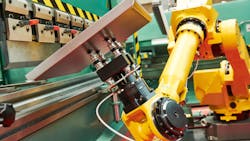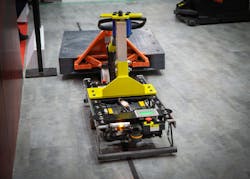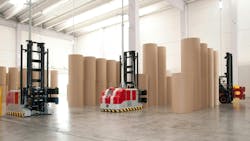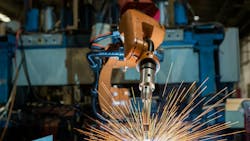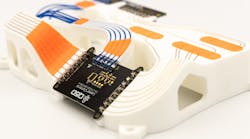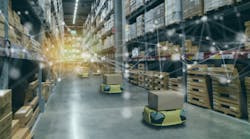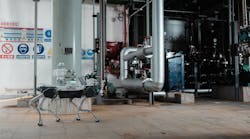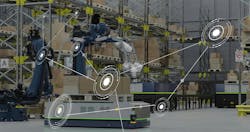Next-Generation Robots will Rely on Integrating AI and Motion Control
Not long ago, the idea of robots integrating into everyday human life belonged firmly in the realm of science fiction. Today, over 3.47 million robots operating worldwide continue redefining that notion.
Of those 3.47 million robots, 517,000 (almost 15%) were installed in 2021 alone. Expansion is rapid, and AI technology promises to further supercharge this growth by simplifying one of the greatest challenges in manufacturing robotic solutions: motion control.
How exactly are AI (artificial intelligence) and motion control intertwined? And what obstacles stand in the way of implementing automated solutions? For OEMs, engineers, and stakeholders in sectors from healthcare to logistics, the answers lie in an examination of the underlying technology.
Motion Control: Fundamentals and Applications in Robotics
Simply defined, motion control is a machine’s ability to enable precision movements via a closed-loop system of action and control. Given an action command, the robot’s components act as follows:
- Actuators convert energy (electrical or hydraulic) into physical motion, allowing the robot to interact with its environment and perform tasks such as lifting, gripping, or maneuvering.
- Feedback systems collect real-time data on the resulting movement — such as position, speed, and force — and relay this information back to the controller.
- Controllers interpret this feedback data, adjusting commands to the actuators to ensure follow-up and proper task completion.
Essentially, the actuator either executes the request or, when it fails to do so, corrects it in real time.
Automated warehouse forklifts provide a pragmatic example of this in action. While these machines follow a predefined pathway, powerful motion control systems enable them to recognize unexpected obstacles — an incorrectly positioned pallet, for instance — and adapt accordingly.
The Evolution and Diversity of Modern Robots
While motion control may seem conceptually straightforward, practical execution involves a complex combination of precision engineering and advanced mathematical algorithms. Intricate hardware layered with trigonometric calculations ensures that each robotic movement is safe, efficient, and precise, regardless of application.
A robot’s specific design and motion control requirements vary significantly depending on its function. Unlike the humanoid figures often portrayed in science fiction, real-world robots are specialized for practical, task-oriented purposes:
- Stationary machines – These include the robotic arms commonly found in manufacturing plants, performing tasks like welding, assembling, or painting. Advanced 3D printers also fall into this category. Though fixed in place, these machines demand highly reliable motion control to ensure consistent, repetitive actions.
- Automated mobile machinery – Robots in this category include autonomous mobile robots (AMRs), automated guided vehicles (AGVs), and automated storage and retrieval systems (ASRS), and they operate in more dynamic environments. Their mobile nature demands sophisticated motion control algorithms capable of navigating obstacles and adjusting to real-time changes in their surroundings.
- Collaborative robots – Designed to work alongside human operators, “cobots” accounted for 7.5% of newly installed industrial robots in 2021. Due to their close interaction with humans, cobots rely on advanced motion control systems to maintain safety without compromising precision or productivity.
In all these cases, motion control is the central component that upholds the three essential pillars of robotic operations: safety, efficiency, and reliability.
The necessity of these three elements only grows in industrial settings — a robotic vacuum cleaner getting stuck on a piece of furniture is inconvenient, but an automated storage and retrieval system failing to deliver luggage for a major airline or building materials for a construction project could lead to much more significant disruptions.
Key Drivers in Motion Control Technology
Experts project robotics and physical automation to account for 25% of industry capital spending between 2022 and 2027.
Several pivotal factors are driving this surge in investment:
- Technological advancements in automation that allow for increasingly diverse applications
- Industry demands for increased productivity to maintain a competitive edge
- Labor shortages and rising costs in sourcing skilled workers
Beyond addressing common industry challenges, automation offers two fundamental advantages: reliability and consistency. Particularly for sectors that demand continual repetition, robots are the ideal workers as an AGV will never tire, get sick, or quit its job.
This reliability is crucial in industries where small disruptions can add up to significant delays or losses.
For example, robots can maintain a steady production pace in a manufacturing environment, minimizing the risk of costly errors and rework. Automation ensures that warehouses run smoothly in logistics and supply chain operations as well, moving inventory efficiently regardless of the time of day or environmental conditions.
The Impact of AI on Robotics
Far from replacing human workers, AI-powered automation allows their role to evolve.
For example, if a company could automate its repetitive and physically demanding tasks, the workforce could then be redirected into roles that preserve and leverage uniquely human qualities: creativity, critical thinking, and problem solving.
Such a future may not be as far off as one might think.
While AI is often naturally associated with large language models such as ChatGPT, it is worth noting that AI existed in the automation industry well before this, albeit in a different form. The aforementioned robotic vacuum cleaner is one example — an early AMR programmed to calculate new routes based on internal rules rather than any operator input.
Notably, businesses have incorporated AI-powered robotics into 20% of all industry operations as of 2022. This is significant but still lags behind AI-powered software, which sees nearly double the cross-industry adoption at 39%.
This increased attention towards advanced AI solutions nonetheless promises much more powerful, dynamic applications in robotic machinery. For instance, AI could be leveraged for:
- Data collection and analysis to optimize robot movement and improve productivity
- AI-powered predictive maintenance to reduce costs and minimize machine downtime
- Real-time simulation to test and refine systems before production
- Energy usage optimization to prevent waste and promote more sustainable operations
These examples are already proven applications; no doubt there are many more in development. Peripheral technologies such as machine learning may further enhance the software side of motion control technology, accelerating mobile machinery’s ability to adapt to new environments.
For OEMs and engineers to align with these automation trends, it’s necessary to understand the technologies that drive them, from electrification and motion control to the latest AI advancements.
Read more robotics related content in the articles below.
Challenges to Implementation
Since its conception, the idea of robotics has been met with skepticism. Can machines truly operate safely without operator supervision? Is the upfront cost worth it versus simply hiring additional staff?
While previous data points make it clear that these objections have largely been addressed, challenges remain. For instance, despite promising applications in the medical field, AI-powered robots only see 11% adoption, indicating a large gap for growth.
This is just one example that highlights the complications involved in implementing this technology:
- Safety – Systems often encounter scenarios simulations cannot predict, demanding more advanced motion control algorithms for safe operation. This is especially vital in environments where robots interact closely with humans or perform delicate tasks.
- Expertise – Robotics engineers and technicians must navigate the unfamiliar territory of AI, electrification, machine learning, and more. This can be a daunting transition for many companies, particularly those with a legacy in traditional mechanical engineering.
- Cost – Aside from the upfront costs of purchasing and installing robotic systems, ongoing expenses related to maintenance, updates, and potential replacements can be a barrier to adoption.
These difficulties, while significant, can be overcome.
From a safety perspective, AGVs are not inherently inferior to operator-driven vehicles. In the right application, the opposite is often true, with automated vehicles enhancing safety by eliminating the possibility of human error and fatigue — especially when performing repetitive tasks.
Nonetheless, regulatory bodies continue to ensure proper safeguards are in place. Safeguards are good, as they force OEMs to innovate and adapt, which in turn refines the plethora of products that comprise automated solutions.
Such innovation, born of necessity, has ultimately helped solve the expertise shortage. Iterative testing and consulting with industry suppliers often promote rich experience and connections across every link in the supply chain, from parts suppliers to engineers to manufacturers.
This, in turn, helps address the issue of cost. For companies seeking to leverage robotic automation, leaning into the expertise of credible suppliers and partners is essential. Rather than exhaust resources on an extensive trial-and-error process, consulting established experts enables engineers and OEMs to meet design goals from the beginning, greatly optimizing resource allocation and time to market.
Bridging the Automation Gap: The Future of Robotics
The momentum toward advanced robotics is accelerating, driven by the need for automation and efficiency across industries. As demand for robotics grows, so does the importance of the underlying technology — motion control, AI, and electrification — that ensures safe and efficient operation.
Integrating AI with motion control systems certainly offers promising avenues for performance optimization, from predictive maintenance to real-time simulations. Yet the relatively low adoption rate of AI-powered robotics reveals a significant opportunity; forward-thinking OEMs and industry leaders must act quickly to bridge the gap, capitalizing on this evolving market.
As investments continue to pour into robotics and automation, embracing emerging technologies and partnering with companies that do likewise will be the key to staying at the forefront of next-generation robotics.
This article was written and contributed by Luca Bandiera, Business Development AGV Manager at ZAPI GROUP.
About the Author

Luca Bandiera
Business Development, AGV Manager, ZAPI GROUP
Luca Bandiera is the Business Development AGV Manager at ZAPI GROUP. Bandiera earned a degree in Electronic Engineering from the University of Modena and Reggio Emilia. He started his career at STILL (Kion Group) in the R&D department, focusing on developing electric warehouse vehicles.
In 2021, he joined Zapi, a leading company in battery and hybrid vehicle control, as a Sales Application Engineer. There, he worked directly with Italian customers and provided technical support to foreign branches. Recently, as a Business Development professional for the AGV Market at ZAPI GROUP, he supports all group companies in expanding their business in the self-driving vehicle sector.

Leaders relevant to this article:

